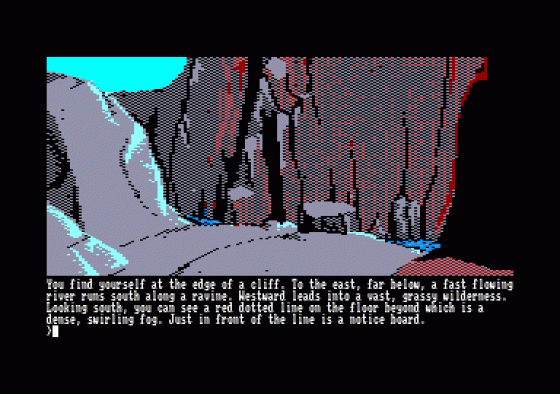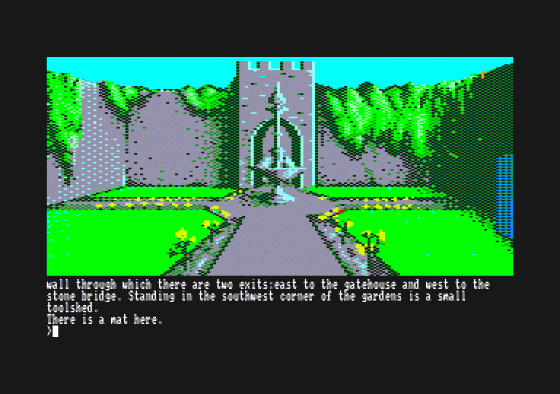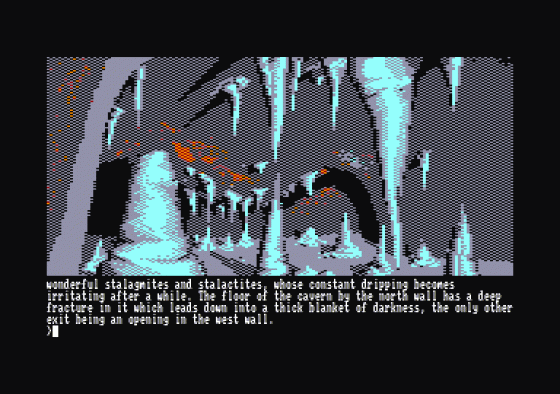
Amstrad Action
 1st April 1987
1st April 1987
Categories: Review: Software
Author: The Pilgrim
Publisher: Rainbird
Machine: Amstrad 6128
Published in Amstrad Action #19
Oooh, doncha just luv that Rainbird packaging?! First in the glossy boxes came the Level 9 collections, Jewels Of Darkness and Silicon Dreams, now comes The Pawn - and this has to be the hottest property yet.
After all, I had my doubts about The Pawn. Everybody has been going on about it, but until recently it had only been available on 16-bit machines so I had to reserve judgment. Of course, I'd seen the pictures. Stunning. But then they should be on a 68000 machine. And I'd heard about the parser. Brilliant. But of course it could be on a 68000 machine with 256K to play with. So what do you get on the Amstrad for your pennies, with only 8 bits and 128K? Here's the complete picture...
The Pawn is a disk-based adventure for the 6128 only - sorry, lads and lasses, there had to be a catch somewhere, and I'm afraid that there are unlikely to be any 464 versions for a while.

It runs in 80-column mode and features some extremely beautiful graphics - about 30 in all. Not only are the pics beautiful to look at, but they are also implemented in the game most effectively. In relevant locations a picture will load from disk when you enter and scroll smoothly down over the screen, leaving the location description uncovered at the bottom.
Once you've checked out the graphics, you can use the up and down cursors to scroll the pictures up off the screen again, revealing your old inputs and responses underneath, and then down again later if you want to have another look. Checking out the pictures, incidentally, is important because they back up the text well and can sometimes suggest, for example, places to look or items to search.
Entering text is quite normal, except that there are some useful editing controls with which, for example, you can delete whole words at a time rather than letter by letter. Furthermore, pressing Escape will recall your previous input for editing if you made a spelling mistake.

The game itself revolves around the characters and politics of a country called Kerovnia. A 55-page booklet detailing the background to the adventure comes with the game, but you don't really need to read it to play. You do, however, need to keep it handy -the program has a protection system that occasionally requires you to refer to the booklet and enter a particular word chosen at random from the book.
Principal characters in Kerovnia are King Erik, who has upset the Dwarves; Kronos the Wizard, who upsets almost everybody; a Guru; an adventurer; and various others, all of whom you can converse with to a limited extent. The characters lead reasonably independent lives and proper interaction with them is essential to completing the game.
The aim of the game is somewhat diffuse. You receive different objectives as you play and are set different tasks by different characters. Some of them seem to be a little harsh - for example there's a polite adventurer who rides a legless horse - you've got to kill him, however strong the bonds of comradeship!

In the final event, however, you must remove a silver wristband which has appeared on your arm. Trying to do this will lead you in and out of many situations and almost certainly result in loss of life at various points! Numerous saves will be required, but since this is a disk-based game, that's relatively painless. The only problem here is that you save by filename, so it would have been nice to have a directory option within the game that you could use to check your "save" disk to see what filenames you've used and what's available.
Playing The Pawn is extremely absorbing - in fact it's almost up to the standard of the later Infocom releases, and certainly a step ahead of anything like Zork. The parser is excellent, allowing most constructs and complex commands. You can use pronouns, "all", "except" and other words to build up very intricate commands. For the most part, however, I didn't find it necessary to be complex in my inputs - most of the puzzles require logic or intuition to solve them, not wordplay. Thumbs up for The Pawn in that respect, certainly.
If you do get stuck, there's an in-built hint facility - you type HINT and then enter a series of codes that appear in the back of the booklet in answer to particular problems. Some of the hints are rather ambiguous, but as your score increases you get access to more straightforward solutions. However, this is one game where I found myself prepared to do battle without hints. The puzzles have an engaging quality that tempts one to solve them, not to bypass them with easy solutions.

Combine that factor with the vivid atmosphere of the program, generated partly by the graphics and partly by the text descriptions, which are reasonably long and very well written - and you've got a pretty addictive experience ahead of you.
What's more, the characters obviously make a big difference. I'm always going on about the need for interaction between player and game characters, and in The Pawn you can "ask" someone about something; "say to" someone, something; "say" something; or just, "someone, something". In each case you'll get a reasonably coherent reply.
I was, however, slightly disappointed by the scope of responses and intelligence of the characters I met. Most of them are confined to replying "Definitely not!" to most questions or commands, but there are enough sensible replies to be had to maintain one's interest in the gentle art of conversation. Certainly better than most other UK games but perhaps I've been spoiled by Infocom's Suspect.
The Pawn is an excellent and inventive game. It must now command a far larger audience than when it first appeared on the QL three years ago, and it deserves it. If Magnetic Scrolls' next game, Guild Of Thieves, due out later this year from Rainbird, can improve on this then we're in for some real UK-sourced adventuring that will give Infocom a very tough time indeed.
Other Reviews Of The Pawn For The Amstrad 6128
The Pawn (Rainbird)
A review by Bill Brock (Amstrad Computer User)










